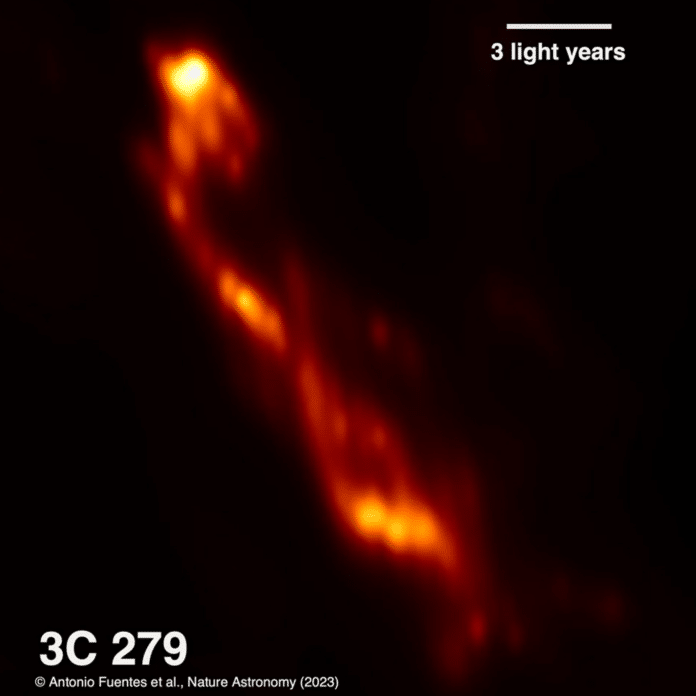A subset of active galactic nuclei known as blazars is made up of galaxies that have a center supermassive black hole that is consuming matter from the surrounding disk. They are among the tiny percentage of quasars with plasma jets aimed nearly straight at the observer.
Astronomers from the Max Planck Institute for Radio Astronomy (MPIfR) in Bonn, Germany, have recently imaged the innermost region of the plasma jet in the blazar 3C 279 at an unprecedented angular resolution. They have discovered remarkably regular helical filaments, which may necessitate a revision of the theoretical models that have been in place up to this point for explaining the processes that lead to the production of jets in active galaxies.
Researchers obtained the highest-resolution image of the interior of a blazar to date, thanks to RadioAstron, the space mission for which the orbiting radio telescope reached distances as far away as the Moon, and a network of twenty-three radio telescopes distributed across the Earth. They also observed the internal structure of the jet in such detail for the first time.
The jet was found to be shooting from a supermassive black hole at the heart of a distant galaxy. The jet, which comes from the heart of a distant blazar called 3C 279, travels at nearly the speed of light and shows complex, twisted patterns near its source. The jet has at least two twisted filaments of plasma extending more than 570 light-years from the center.
Eduardo Ros, a member of the research team and European scheduler of the GMVA, said, “This is the first time we have seen such filaments so close to the jet’s origin, and they tell us more about how the black hole shapes the plasma. The inner jet was also observed by two other telescopes, the GMVA and the EHT, at much shorter wavelengths (3.5 mm and 1.3 mm). Still, they could not detect the filamentary shapes because they were too faint and too large for this resolution. This shows how different telescopes can reveal different features of the same object.”
The plasma jets that emerge from blazars are not exactly uniformly shaped and straight. They display twists and turns, illustrating how the forces surrounding the black hole impact the plasma. These twists in 3C279, known as helical filaments, were discovered by astronomers to result from jet plasma instabilities.
They discovered during this procedure that the previous theory they had employed to describe how the jets changed over time was no longer valid. Therefore, to explain how such helical filaments develop and evolve so close to the jet origin, new theoretical models are required. This is a considerable challenge, but it’s also a fantastic chance to learn more about these incredible cosmic events.
Guang-Yao Zhao, presently affiliated to the MPIfR and a member of the scientists team, said, “One particularly intriguing aspect arising from our results is that they suggest the presence of a helical magnetic field that confines the jet. Therefore, it could be the magnetic field, which rotates clockwise around the jet in 3C 279, that directs and guides the jet’s plasma moving at a speed of 0.997 times the speed of light.”
Andrei Lobanov, another MPIfR scientist in the researcher’s team, said, “Similar helical filaments were observed in extragalactic jets before, but on much larger scales where they are believed to result from different parts of the flow moving at different speeds and shearing against each other. With this study, we are entering an entirely novel terrain in which these filaments can be actually connected to the most intricate processes near the black hole producing the jet.”
Anton Zensus, director of the MPIfR and one of the driving forces behind the RadioAstron mission over the last two decades, states: “The experiments with RADIOASTRON that led to images like these for the quasar 3C279 are exceptional achievements possible through the international scientific collaboration of observatories and scientists in many countries. The mission took decades of joint planning before the satellite’s launch. Making the actual images became possible by connecting large telescopes on the ground like Effelsberg and by a careful analysis of the data in our VLBI correlation center in Bonn.”
Journal Reference:
- Fuentes, A., Gómez, J.L., Martí, J.M. et al. Filamentary structures as the origin of blazar jet radio variability. Nat Astron (2023). DOI: 10.1038/s41550-023-02105-7
